You dig oddball guitars and strange, rare equipment. Sure, a Fender Telecaster is a great guitar (I have a 1969, and I love it), but there’s something about the weird ones that pulls you in or you wouldn’t be reading this newsletter. Fenders, Gibsons and the rest of the big boys are fine, but if you want a guitar that looks like a kitchen counter, perhaps made out of something more…uh…interesting or futuristic than wood…or one with more buttons than your uncle’s accordion (and you know you do!), you are forced off the beaten path to find your treasure.
So, then, let’s say you’ve got your wonderful freakazoid guitar collection underway. What’s the next move for you’ You like collecting gear, but you think those folks who spend three grand on a 75 Strat are loons of the highest order. Why, for that kind of money, a sane person could buy ten guitars! (well, sorta sane, anyway) So you got a few offbeat guitars and now you need something to plug your Guyatones and Kawais and Kapas and Airlines and so on into. What’s the point of getting such a strange one-of-a-kind guitar and then plugging it into some amp that anyone could wander into a guitar center and buy off the rack. So, where do you go from here?
Here’s a bunch of oddball and wonderful off-brand sleeper amplifiers you may or may not have heard of. For each brand/model, I’ll include some of the features (the Skinny), the tube complement and the ease or lack of ease for a DIY-er to work on the amp (Geek Love), a sound comparison to a more familiar amplifier (Sounds Like), and what you might expect to pay, and what price would be an absolute steal (Price). I’ll also include a section on why you should want this amp, and why you might want to stay away from this amp. (Why You Want This Amp/Why You Don’t Want This Amp).
Here is a group of, in my opinion, seriously undervalued amps. Even the priciest of them are still, in these times of inflated value for anything tube or tweed, well worth the coin.
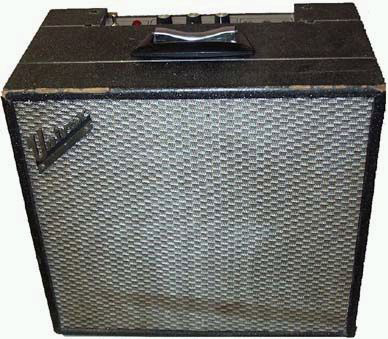
Univox U45 Guitar Amplifier
1) Univox U45 and Univox U60 Guitar Amplifiers
Got the blues, but don’t want your wallet to have them too’ Check out the Univox U45 and U60 models.
- The Skinny: These are relatively simple amps with a very basic control panel (Volume and Tone and only Speed for the Tremolo). Most of these are housed in a black tolex cab that holds a single 12″ speaker (usually a ceramic Jensen). With a silver grille cloth and the Univox (or Lafayette) logo, these are good looking, if somewhat aesthetically pedestrian amps. Very lightweight – super for recording or a small jam where you need a nice bluesy overdrive at low volume. Not the most versatile amp on the list, but a very cool one-trick pony at, often, a great price.
- Geek Love: Both these amps use the seldom-seen 6MB8 output tubes. The U45B’s I’ve seen have two 12AX7’s for preamps, while the U60’s have had either two or one 12AX7. They are low powered (8-12 watts) amps, with a great smooth overdrive with crisp highs and woody, warm mids and lows. Cathode-bias, non-feedback loop amps allow for plenty of spongy tone and singing sustain. These are Printed Circuit Board (PCB) amps from the late 60’s and early 70’s, but they are incredibly simple in their layout and they are a surprising joy to work on. Well laid out. Simple wiring to follow (for a PCB amp). Plenty of space for upgraded Sprague Atom, or other high end, Electrolytic caps. This means either you’ll enjoy working on them, or your tech will have fewer headaches, which translates (or should) into lower repair and maintenance bills.
- Sounds Like: Well, the 6MB8 output tubes have a tone all their own. They are a little bit like a slightly rounder, mellower EL84. They reach overdrive and grit a little sooner, at lower volumes. Think of a low(er) powered Vox AC-15…the same woody warmth when overdriven.
- Price: Expect to pay between $150-$250 for a U45 or U60 in great condition. They’re very lightweight, which makes them cheaper on shipping if you see it on Ebay (should be 25-30 bucks anywhere in the lower 48, slightly more north of the border), or an on-line dealer. Anything under $150 for a good working model is a steal. Your friends will drool when they hear the tone you get out of this little unsung brand.
- Why You Want It: You get great tone for well under $300? You need an answer for that? They generally have 20 watt Jensen Special Design speakers in them that weren’t pushed hard (due to the power of the amp). A small gig (to be fair, a VERY small gig or, for bigger shows, a mic’d through a PA gig)/practice/recording amp that’s easy to repair for this price? Why not?
- Why You Don’t Want It: The tremolo rarely works in these, and when it does, it’s anemic and only the frequency (SPEED) is controllable. You will need a good tremolo pedal if you use that function. Plus, you’ll need a reverb pedal, if you want it, since this has none. The 6MB8 tubes are strange, but they can be found NOS and they won’t kill you, price-wise (30 bucks a matched pair seems to be the on-line price). Stay away, in general from NATIONAL tubes. They are the easiest to find, and there’s probably a reason for this. I haven’t heard a good set yet of them in the 6MB8s OR the 7189A’s. Another minor negative about the Univox models: While you can never tell about such things, they show no signs of being collectable. So, buy a player, not a collector. None of these factors are prohibitive, but they are things to consider if you’re negotiating for one of these little gems.
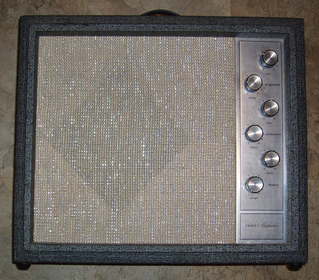
Silvertone 1482 Guitar Amplifier
2) Silvertone Amp 1472 and Silvertone Amp 1482
Since the boutique amp boom of the early 90’s, one of the most commonly copied circuits is the 50’s Fender Tweed Deluxe. And while this IS an awesome amp, one absolutely worthy of copying, there are several low-budget funky alternatives for those who love the bluesy grind of a 6V6 circuit. The most frequently seen, and hence, easiest to find are the Silvertone Amp 1472 and 1482 Model. AKA the “TV set” model. A new boutique version of this general circuit can cost you around a grand and up. Heck, a KIT for this amp goes from $400, and more. And those prices are legit – there are cool parts in them. But why not buy one of these models and get your hands dirty for under two hundred bucks and get that Link Wray Rumble tone on the cheap?
- The Skinny: Two channels, which are bridge-able with a patch cord for super thick sound. Volume, tone controls for each channel, and speed and depth for the Tremolo (foot-switch for the Tremolo, which is frequently lost on old models). No Reverb. A single 12″ alnico speaker, frequently a Jensen or Oxford, depending on the year. This little guy, made by Danelectro, comes in a small, portable and astoundingly light cabinet. Covered in a gray wallpaper-ish material, and front-facing controls running vertically down the side, this is one cool looking amp.
- Geek Love: This is where it earns the nickname of a poor person’s Tweed Deluxe, even if that’s stretching the facts a bit, since it the transformers and the rectifiers are quite different. Still, it does have a lot of the same tone, as a result of the cathode-biased 6V6’s in a non feedback loop amp. Two12AX7s for preamp, 6X4 rectifier, 6AU6 (for tremolo) and two 6V6’s for output. These amps are very easy to work on, well laid out and astoundingly simple for a gigable amp. A cool geek factor is that, as a result of the way the amp is laid out in back, you can sub 6L6’s in the output for a little more headroom, and the trannys seem to be able to handle the extra heat nicely in these models.
- Sounds Like: Well, like their reputation (and nickname) says, they sound a lot like a Tweed Deluxe, though a bit looser and wilder. Like the Tweed Deluxe spunky, unkempt friend. Decent cleans at low volume. Nice bottom, rich, textured mids. But, get the volume up past 11 O’clock, and these amps really start to show their stuff. Great overdrive – the classic American tube push of the 6V6’s. Just a great, classic blues and garage rock tube sound. Great, deep 60’s style tremolo with a good sweep of speed control. I’ve A/B’d several of these models with a buddy’s 1958 Tweed Deluxe and they handle the comparison well. Are they as well made as the 1958 Fender? Nope, not at all. They’re not as rugged or durable, or well put together. BUT, they are not $2,500, either. Which leads us to:
- Price: You can snag these in excellent condition between $250 and $300. But, only get a minty one if you’re a collector. If you’re a player, these cheap pressed paper cabinets will get dinged so quickly it isn’t funny. So, why pay more if you’re going to use the amp? You can get these in great playing shape frequently in the $150-$225 range (a friend of mine just got one at a Los Angeles pawn shop, hardly the town for bargain pawn deals, for $150). They are cheap to ship, because of the light weight. If you find one in need of minor work (a tune up, new tubes and/or a cap job), you can get a steal in the low $100’s. Just stay away from the ones with rust on the transformers. It happens a lot with these type of amps – possibly because they were quickly forgotten by budding guitarists and left in their parent’s basements and garages for years of quiet neglect.
- Why You Want It: For the price, it’s just a great amp. Actually, for a good amount more, it would still be a great amp. Super for any recording studio (they’re an awesome little harp amp, too) with lush fat cleans at very low volume, and total blues and garage snarl at mid and high volume. Really easy to find tubes, and at this price you can buy a super speaker to replace the original if it’s tired, and get boutique tone well under $400. (It’s a good idea, if it’s in decent shape, to take out the original speaker, anyway. They aren’t made to crank and they’re made of 40 year-old paper. Keep the original in working condition if/when you want to sell it, and it will retain more value). They’re way cool looking, too.
- Why You Don’t Want It: Well, there’s really no reason to not have one of these. BUT, the big strike against them is their cabinet construction, which makes them a dubious choice for touring. And while you should never allow your friends to sit on your amps, these Danos are amps you REALLY don’t want folks sitting on. Crush, kill, destroy.
- See Also: There are several great and affordable vintage amps, made by Danelectro and Valco, that are so similar in sound to the Silvertone 1472 and 1482’s that giving them their own entry here would be redundant, so I’ll give a short list, with some important ways they differ from the above amps.
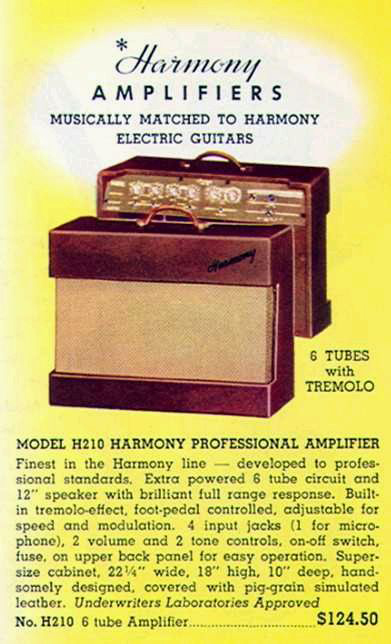
Harmony 210 Guitar Amplifier Ad
Harmony Model H210 Guitar Amplifier
The Airline (made by Dano) mid-60’s 90813A amp. Much like the 1482 (the guts are the same), but a top mounted control panel, in black tolex-look paper. You can’t fit a 6L6 in these, as a result of the back cab angle, but otherwise, they are the same awesome amp. You can get these, often, in the $200 range. Highly recommended.
The Harmony 210 (made in the late 50’s by Valco). While several Valco models (mostly the SUPRO-labeled ones, as a result, partially of all the Jimmy Page rumored usage on the early Zep albums) are starting to fetch major dough on the vintage market, these Harmonys are still pretty much dirt-cheap. This may be partially as a result of Aspen Pittman’s misinformation about Harmony amps in the latest Tube Amp Book and we should thank him for this. Where else can you get a wood cabinet (mostly, anyway, except for the top) two 6V6 amp with a 12″ alnico Jensen, made by Valco, for under 200 bucks’ These are sweet amps, and they use a 6X5 rectifier, which is cheap and easy to find.
The later model Harmony 306A (in the black paper covering with the blue painted control panel with white chicken-head knobs) was also made by Valco and has the same features with only a 5Y3 rectifier as the difference from the Harmony above. You can get these between $200-300. The Jensen Special Design ceramic speaker is a nice feature – it sings the blues very well.
The best (and most rare) of this cool bunch, though, may be the Valco-made Kay 6V6 amp. These have all of the great sound and features of the amps above, but the added cool factor of a two-tone (cream and red) cabinet and a swirl grille cloth. PLUS, they use the more common (these days) 5Y3 rectifier, which also makes replacing (if you have to) the power transformer easier and cheaper. These go in the $175-275 range. These are frequently mis-labeled as “Airline” amps – if you see a two 6V6 amp with a 12″ speaker that looks like a bigger red and cream version of the familiar, small (and anemic) Kay 703, snag it, no matter what the seller is calling it. Inside, this and the Harmony 306A are the same amp. They sound sweet – and they look like what made have happened if Frigadaire and Studebaker merged and started making amps.
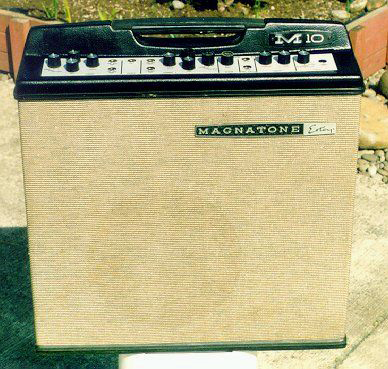
Magnatone M10A Guitar Amplifier
3) Magnatone M10A Guitar Amplifier
Want some more features, but still don’t want to take out a 2nd mortgage for your rocking amp collection? Try the Magnatone M10A. The easiest-to-find of the Magnatone (by this time in the mid 60’s, Estey-owned) suitcase models, these are either some of the ugliest or funkiest amplifier ever made, depending on your take on them.
- The Skinny: This is one of the most well-appointed and versatile tube amps ever made. Both channel one and two have Volume, Treble and Bass controls, plus a three-position switch for ‘Mellow/Bright/Tone Boost.’ Channel One has tube-driven Reverb (control only for Depth) and the truly amazing Magnatone true pitch shift Vibrato (Speed and Depth controls). If you’ve never heard real Vibrato (Fenders and other amps used Tremolo, which is volume shifting, and labeled them Vibrato’only Maggies actually shift pitch) in an amp, it IS a treat.
- The two channels are bridge-able by an input labeled ‘stereo’ which exponentially expands this amp’s versatility. Put channel one on ‘Bright’ (you get the Reverb and Vibrato as long as you’re using channel one…only when channel two is used alone are they not activated), and channel two on ‘Tone Boost’ and you can dial in all kinds of great chime and grind. This is an amp that you can tweak and play around with for hours.
- Reverb and Vibrato are foot-switch able. All this goes into a closed back cabinet that houses a 12′ speaker (I’ve seen Utahs and Oxfords in these, along with Jensen ceramics). There’s an ‘Extension Speaker’ out on the control panel.
- Geek Love: Magnatone is somewhat famous (infamous) for using oddball tubes in their amps (such as the rare, expensive and hard to get 6CZ5’s in the awesome 280 Stereo Vibrato amps from the late 50’s), and this amp is, sadly, no exception. The preamp and reverb driver and recovery tubes are the usual suspects (12AX7’s and 12AU7’s, depending on the application), but the output tubes are the rare 7189A’s in cathode-bias. On the plus side, this is a great sounding tube. It’s the high-voltage sibling of the 6BQ5 (EL84), with a tolerance for a 100 more volts on the plates. An EL84’s on steroids, with a great overdriven sound.
- Inside, this amp is a tech’s nightmare. You may have a qualified tech in your town, but he or she may have never seen a Magnatone. And if they have, they may have seen the more common and simpler 213 and 260’s made by Magna Electronics in Torrance, CA. When the company moved after the Estey purchase, followed, years later by the introduction of these suitcase models, the amps got even more complex. The power supply and solid-state rectifier are in the bottom of the amp. They are connected, via much spaghetti to the chassis, which is housed in the suitcase top. Here, you have a (relatively) complex circuit with plenty of places where things can go wrong. In engineering, it’s always nice to have a simple design that leaves fewer areas where things can break or go wrong. This amp makes you (or your tech and your wallet) pay the price for all of its cool features.
- Sounds Like: Nothing you’ve ever heard, in many of its settings. However, you can get some very British sounds out of this American-made (1964-66) amplifier when you play around with it. Set up properly, these can crank to rival any 18-watt Marshall or Vox AC-15. At lower volumes, you can’t beat this lush (more Ampeg-ish than Fender) Reverb and Vibrato for surf sounds, ambient music or clean country. In between, it gets a nice crunch rhythm. This amp can do anything but metal, and do it well. Really well. And it will look like a mid-sixties Samsonite Luggage bag while doing it, which may or not be a positive for you.
- Price: In mint condition, expect to pay anywhere from $450-$550 for this amp. Beat up cosmetically, you can score them for between $200 and $350. They cost a lot to ship (it’s VERY heavy for a single 12′ combo). And because of their strange and finicky construction, the suitcase models frequently get damaged in shipping. Consider trying to find one locally, but if you get one at an on-line site (auction or shop), make sure they know how to ship an amp (true of all vintage amps, but especially true here).
- Why You Want One: The tone, man, the tone! The Vibrato. You hear this thing, and you’ll want to grab Elwood and Jake and get the band back together. This is simply one of the best-sounding, most versatile amps you’ll ever have the pleasure of playing. Hook it up to an extension cab, let that vibrato and reverb work on you, and get lost. It responds really well to different guitars and pickups and has rich cleans and creamy overdrive. If you’re just going by tone and price, it’s hard to argue against the M10A. And, you’d be one of the few people around who have one, and they are VERY funky looking.
- Why You Don’t Want One: Here’s the rub. Actually, there’s a few rubs involved with this amp. A pair of good, NOS 7189A’s cost at least $50. Sometimes, much more. Techs, many of them, have no idea how to work on a Magnatone (many do, but I’d check with your local people before you buy one). You CAN modify this amplifier to take EL84’s (a MUCH cheaper tube that sounds great in many circuits), but I haven’t heard one that sounds quite as good as it did with the 7189A’s. The Vibrato rarely goes bad in these (a good thing, as the Varistors are hard to get), but the Reverb is temperamental. The whole amp is oddly put together and top-heavy. They get damaged so often in shipping simply because they are not very well designed (two thin aluminum arms carry most of the tension and weight of the top). It has gig power and tone, but it doesn’t like something as simple as a bumpy ride in a car. A Fender Twin, it ain’t.
- I am a huge fan of rugged amps you can treat like the tools they are. I HATE finicky amps that always need attention if you take them out of the house. The fact that I would not get rid of my M10A for anything except 10% above market value speaks volumes for what a beautiful and individual sounding amplifier this is.
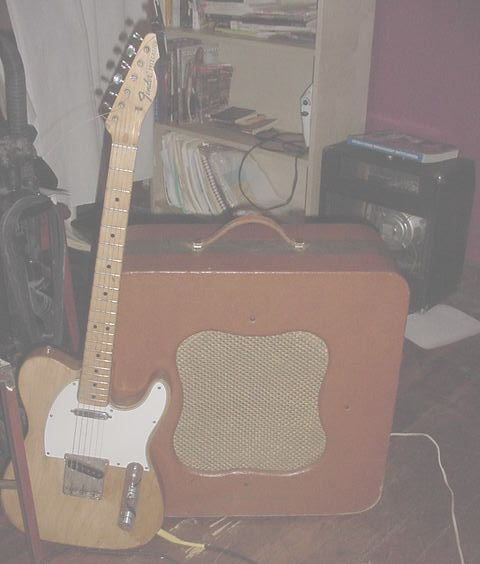
Fender Telecaster Guitar & Danelectro Challenger Amp
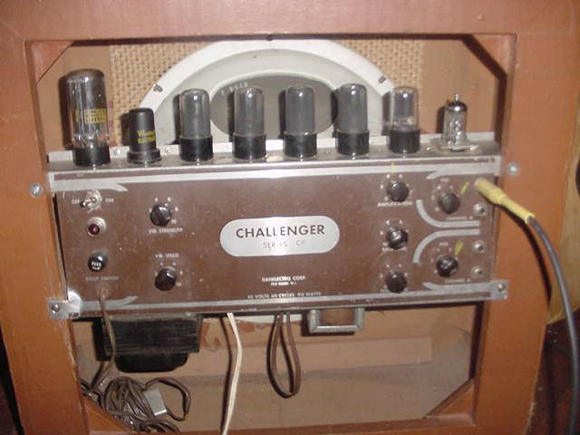
1950’s Danelectro Challenger Guitar Amplifier
4) 1950’s Danelectro Challenger Guitar Amplifier
Who has ever played in a band with a guitar player would wouldn’t turn down because he (or she, though in my experience, this is sadly just us guys) couldn’t get ‘their tone’? Or, worse, who has BEEN that guitar player (my hand would be raised if I weren’t typing)? It’s an understandable, if annoying, dilemma. You want pure, beautiful, overdriven tone, but you can’t get it unless you amp is really pushed. If you own a Fender Twin Reverb, you may be the most hated person in your band. Want some great gigging tone with an early breakup, yet a lot of punch and a huge bottom’ You want a mid 50’sDanelectro Challenger (from their ‘C’ series). An amp that sounds huge, even at low volume settings.
- The Skinny: Ain’t nothing skinny about this one. If it ate, it would eat nothing but fried stuff and starches. If it could talk, it’ll swear a blue streak. It’s built for comfort and it’s not build for speed and if you want to sound like Hubert Sumlin (and if you don’t, I feel safe in saying, without fear of argument, there is something wrong with you on a fundamental level, my friend), you might want to try this amplifier out. Two channels, but they are independent and can’t be bridged. Hard wired footswitch Tremolo (mis-labeled, of course, ‘Vibrato’). Volume, Bass and Treble on each channel. Two inputs per channel. A 15′ alnico speaker. That’s it. This is a set it and forget it amp’control your grit, grease and cleans from your guitar’s volume and tone, and just play all night.
- Geek Love: Here is where it gets really interesting. A four 6V6 output section gives this amp lots of snarl with more power and oomph than most of us are used to hearing from 6V6 circuits (which usually come in pairs). Preamps are a 12AX7 and a 6SN7. Tremolo is driven by a metal-cased12SJ7. Rectification comes courtesy of a 5U4 tube. The insides of this amp are a little clustered and messy. It’s point-to-point wired, but not as well laid out as, say a Fender or an Ampeg of the same period. It is, however, spacious and pretty simple and easy to work on. An issue of working on this amp is that the chassis is rather awkwardly mounted to the cabinet, and sometimes it feels as if you could use three hands to get it in and out of the amp. But, overall, it’s pretty straightforward and the tubes are not very hard to find, and the guts are pretty simple to service.
- Sounds Like: It sounds a little bit like any number of the Valco or Danelectro models with two 6V6’s but, with the doubling of output tubes, plus the 15′ speaker, MUCH bigger and nastier. This may be THE sleeper blues club/gig amp out there. At low volumes, you get a rich, thick, warm and bouncy clean sound with great response and dynamics. Turn up the volume (or ‘Amplification’ as it is labeled), and the 6V6’s really get going to the point where this has the rich, classic rock bigness and breakup of the Fender Bassman at a lower, more club and band-friendly volume. Plug a single coil guitar into it, you get chimey, crisp highs, underneath the bluesy breakup. Plug a P90 or humbucker guitar into it, and stand back and listen to the thick, luscious sustain. This isn’t a guitar that’s going to do surf or clean jazz, but for rock, blues, fusion, garage rock or snarly Dave Allen-style instrumentals, man it’s hard to beat. There’s not an amp out there that sounds like this one. The Tremolo is lush and swirling. Set it all the way up and feel the floor move, it’s got so much bottom. Lovely.
- Price: It’s pretty rare, so it’s hard to get a market sense of this as easily as you could an amp that is more frequently seen o the used market. However, in good working shape, expect to pay $350-500 for this amp. Think about it’that’s less that you could probably grab a Peavey Delta Blues for, and it’s a much better amplifier, and one that will increase in value over the years.
- Why You Want It: Well, it’s always nice to have a variety of amps (I think you should have probably one for every guitar, on average, but this is bad math for a successful relationship and home life). And it’s not too common (other than some old Bell and Howell PA’s from the 50’s, or some super expensive Jim Kelly amps from the 80’s) to have a four 6V6 power section, and nothing sounds quite like it. Add that to the 15′ speaker, and you have a unique tonal experience with this amp. The dynamics are fantastic. This is the kind of an amplifier that reminds you these amplifier gizmos are not just things that make instruments louder; they ARE instruments. An amp that responds to the player’s touch is a beautiful thing to feel and hear. This is one of those amps. It’s incredibly lightweight for a large(r) amp. Plus, it looks radical. Fake brown leatherette paper, with a three inch gold stripe around the perimeter, and brown burlap grille cloth all add up to a piece that looks as good in the living room as it sounds on the stage or in the studio.
- Why You Don’t Want It: Great tone, cool looks, a hip factor that’s hard to match (who else has one’ And it looks funkier than Pee Wee Herman’s bike!)…what’s not to love’ Well, the big snag might be its…err… PAPER cabinet. That’s right. Pressed paper! So, if you find one still in one piece after fifty-plus years, consider yourself extremely lucky and find a woodworker or cabinet maker who can copy its simple lines and put the chassis into some wood, and THEN you may take it on the road. As it stands, it would be a tricky and dangerous thing to take this amp out for anything more than a local gig. The good news here is that most weekend woodworkers could copy this cabinet, it’s so very basic. Also, the chassis mounts on four small points, and most of these I have seen have weakened metal on the chassis by the screws. Not the end of the word (it can be re-enforced), but, clearly, a design flaw.
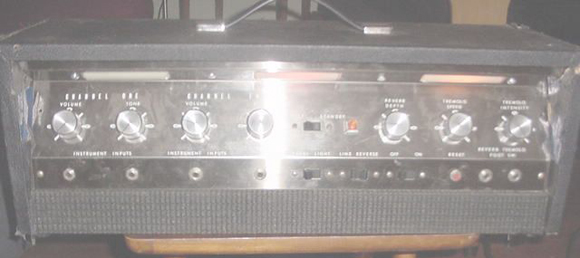
Montgomery Ward 6L6 Guitar Amp Head
5) Montgomery Ward / Valco Two and Four 6L6 Amp Heads
In the wake of Jack White and the White Stripes success, the price of the Silvertone 1484 Twin Twelve (with the two 6L6’s and the 2X12′ cabinet) and the 1485 (with the four 6L6’s and the 6X10′ cabinet) have gone through the roof. They may be worth the prices they’re commanding, but they are no longer sleepers or unknowns on the used market. So, what’s a gear freak to do? Look to the Montgomery Ward/Valco two and four 6L6 heads. These are great amps, somewhat rare, but if and when you see them, they can be had for some really great prices.
- The Skinny: Two channels. Volume, Bass and Treble on each. Depth for Reverb. Speed and Intensity on the Tremolo. All housed in a really cool looking head that has three lights (and a separate switch just for the lights!) that run across the top of the head like a 60’s dashboard. The knobs are huge (silver-dollar sized faces), and with the lights on, they are easy to see and set on a darkened stage. I have never seen one of these with its original speaker cab, but I have run them into cabs with two twelve inch speakers and into cabs with fifteens, and had great luck.
- Geek Love: Both amps (the 40 watt and the 80 watt) use three 12AX7’s in the preamp, a 12AU7 for the Tremolo, and a rare choice of a 6V6 to drive the surprisingly good Reverb circuit. The layout inside of these amps is stunning. Really beautifully structured and very easy to work on. Much better than one might expect from an amp that could be ordered out of a Montgomery Ward Catalog. The particle board case for the head, however, tends to get stripped by the wood screws if it’s been taken in and out too much and/or jarred hard on the road. The smaller head has the two 6L6’s for output while the larger one has four 6L6’s.
- Sounds Like: Well, if the Silvertone 1482 is the poor person’s Tweed Deluxe, these heads are the poor person’s Dual Showman head. These amps offer huge bottom and tons of clean (unusual in the bargain tube amp business) that would be positively great for the surf band on a budget. Try plugging your Eko or your Rangemaster into this and see the cool/rare envy pop in the crowd. Surf will be up, but it will be odd.
- Can you get these into overdrive? Well, yes, the two 6L6 version, at any rate. But it’s a very tight-bottomed, snappy and crisp high-powered overdrive (partially as a result of the solid state rectifier). The 80 watt version of this amp will stay clean until your neighbor’s neighbors are begging you to turn it down and calling the local authorities. This makes it quite the sleeper for the club-sized bass head, as well.
- The big surprise on these amps, as alluded to earlier, is the reverb. Anybody who has owned (and loved) the Danelectro-made Silvertone 1484s and 1485s knows that, great as they are, they have some of the cheesiest reverb ever produced. Their reverb pan is the side of a small tissue box. And it sounds kinda awful. Not even really usable as an odd effect, even after you have long given up on it as a useful reverb. These Montgomery Ward heads, however, use Hammond-Gibbs reverb pans (2 and 3 spring) that are driven by a 6V6 tube and they have a wonderful depth and texture. Very cool. Also, the tremolo has a harder clipping than the smooth tube driven tremolo common in the early to mid-60’s. A monster depth accompanies a wide speed control. Very interesting sounds available from this amp, and a killer rockabilly or surf tube amp.
- Price: While it’s become hard to touch the Silvertone heads in good shape for under $275, their Montgomery Ward counterparts can be had in the $100-200 range with some regularity for the two 6L6 model and a little higher (50 bucks) for the four output tube model.
- Why You Want It: Your surf band is starting to play bigger clubs and you need to Dick Dale the crowd into submission with your mega glissando. If you want to feel it under your Chuck Taylors when your descend-throb that low E-string, but you want gas money left over to get home from the show, this is the amp for you. Plus, it has that cool light-up panel on the front. You can toss in blinking X-mass lights and have a light show while you play. Snazzy. Also, it sounds, like many great clean tube amps do, wonderful with pedals in front of it. This amp likes pedals quite a bit, so if you’re the kind of a player who uses their amp as a pallet for your sound, rather than as the only aspect of your sound (other than the guitar), this might be for you.
- Why You Don’t Want It: Not a lot of negatives. If you don’t like it, the resale value blows, but that only matters if you paid a lot for it. The particle board construction was a cost-cutting measure for a reason: it’s cheap. And, as a result, it breaks easily. But at this price, hey, that’s why they sell duct tape. If you find one in the hundred-dollar range, hell, buy two. Anytime you can get a stylin’ vintage tube amp for less than a boutique pedal, well, you have to buy it, don’t you? Don’t you?
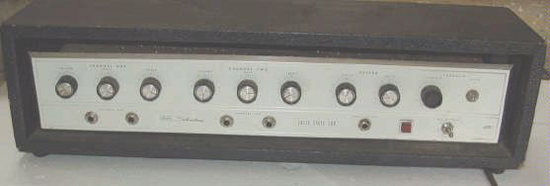
Silvertone 1464 Solidstate Twin Twelve Guitar Amp Head
6) Silvertone 1464 SolidState Twin Twelve Guitar Amplifier
The last amp on the list for now is where I turn away from the tubes and check out the solid state of the nation address. While, in general, tube amps are the thing for vintage tone, it’s true that solid state done right is better sounding than tubes done wrong. Also, if you loved the sound of the first Velvet Underground album, or many of the songs on the Nuggets compilations, you’ve been tapping those fingers on your steering wheel while listening to and groovin with transistors. So, my last amplifier here is a name you’ve heard, but maybe not a model many of us have played, the Silvertone 1464 SolidState Twin Twelve.
- The Skinny: Two channels, one with reverb and tremolo. Controls for volume, bass and treble on each. A lightweight, simply laid out head that tucks, like its tube amp brethren, into the cabinet that houses two ceramic-magnet Jensens.
- Geek Love: Well, there’s not much to love for tech geeks here. SolidState technology offers fewer areas for modification and whatnot. On the up side, not much tends to go wrong with these (unlike, say, the first Fender Solid State offerings, which were notorious for not working and equally notorious for their shrill sound when they did). The filter caps DO go bad (just like on the tube amps), and they are pretty easy to get to and replace.
- Sounds Like: See above. Listen to the guitar on ‘Run, Run, Run’ or ‘Waiting For My Man’ by the Velvet Underground, and you’re hearing the swampy trashy overdrive of the Silvertone (and a solid state Vox bass amp, according to most reports). It’s edgier than most tube amps, but these Silvertones are NOT without warmth, by any means. The tone controls are very responsive, and the amps are lovely through their clean range for Jazz, Country, or Surf music. And, with a good pedal in front of them, you can get some great crunch from them.
- Price: The heads show up a lot on eBay and on-line sellers (and pawnshops), and they don’t command mucho dinero. You should be able to catch a head in really good condition for $100 or under. With a minty cab (and, remember, those twin twelve Jensens work with your tubes heads, too…good to have around), you’re still talking about under two hundred bucks. How cool is THAT?
- What You Want It: Like I said, the cab is a good thing to have. It’s also really great to run this along side a tube amp and either A/B foot-switch them for clean and overdrive, OR just run them both together for fat, rich complex sound. Too cool. And while I don’t think many players would choose solid state as their main sound, it’s good to have a variety of tones at your fingertips. Plus, the price is right. For now.
- Why You Don’t Want It: Well, they aren’t worth much on the resale market, so you may find yourself with an old solid state head with a bad rep (deserved or not) that is hard to get rid of. But that only applies if you want to get rid of it, which I don’t think most folks would, especially if they got it for around a hundred and fifty clams.
- A minor negative (seeing a trend here with these cheapies): The cab is an odd combination of particle board and pressed paper. If Fenders, Traynors and Hiwatts are the brick houses of the amplifier world that no amount of huffing and puffing can bring down, well, under minimal stress these Dano made cabs are pretty much like a trailer park in a hurricane. They’re not made for the rough life’so baby them a little bit, and you’ll get many more years out of them.
So, there you have it. Some affordable amplifiers that will go well with your oddball guitars. And they will keep your friends (and your drummer) shaking their heads and saying, ‘A new amp’ I thought you had an amp’ Why do you need two (or three, four, five, etc….whatever number your sickness has progressed to.)’ Tune up, plug in, drop out. Enjoy.

The Harmony 306 amp I mention in this piece (and the H210) and NOT made by VALCO–but by Lectrolab. Sorry for the error.
Also–the Kays are not made by Valco (they were made, oddly, by Kay)…and the Magnatone M10 is cathode-biased AND fixed bias. I THINK that’s all the errors I needed to fix here 🙂
love this site. i think i have the kay or something very similar. red oldschool plywood with picture frame tongue n groove casing type of trim. 12 inch jenson from 50s, the 5YE, 2-6V6GT, 12AX7, 12AX7. metal part of amp has ultralinear handwritten on it. had yellowish tolex i kept for new box. white chicken head knobs. a killer harp amp. not so much for the guitar though
looking for circa 60″s silvertone twin twelve speaker cab, with or without speakers.
I have the 4-6L6 montgomery ward amp, and the tremolo for this is a 12ax7 (as indicated on the tube layout sheet) and not the 12au7. Perhaps the 2-6L6 uses the 12au7? There are a lot of variations in these amps. I also have a 4-6L6 without tremolo or reverb, there is a 2-channel “PA” model with 2-6L6 and reverb. There is also a 1-channel 2-6L6 no reverb/tremolo version. I would also note that the two channels on the 2-6L6 amp described in this article have “tone” controls rather than separate bass and treble (as evident in the picture).
Another oddity about the 4-6L6 amps is that they are sort of “dual mono” — that is, instead of being an 80-ish watt amp, it is two 40-ish watt amps (I think there are some Gretsch amps that have this configuration).
Very nice article on rare, beautiful-sounding amps for which there is little information available.
Got a large vertical racing stripe 212 oxfords I believe and the matching Harmony 545 head that is supposed to be solid state in accordance to info on the last site I had found and lost. Looking for comments on Harmony 545 212 vertical racing stripe, unit approx.55 inches high and that is guess. Reply to: guitarslinger54@yahoo.com
Actually Sterling from the velvets played a guyatone and a kent through a silvertone 1484 twin twelve in the early velvets.
http://midnightmacciato.files.wordpress.com/2010/09/the-velvet-underground-2.jpg?w=519&h=321
I’m currently trying to get my hands on one for a decent price as we speak
I have a harmony 550 reverb head that cool trying to sell it
speaking of great amps, my Lectrolab 600 is so great sounding that for a couple years I left the Two-Rock at home! Mine is two EL 84s, two 12AX7s and a 6AU6, w/ the rectifier having been changed to FREDs. Sitting on another 12′ cab, w/ or w/out pedals, a very pretty, gutsy, gig-able amp weighing very little. Fat Dog at Subway Guitars in Berkeley CA had one w/ two 6V6s that was gorgeous sounding. What’s the skinny on them, anyway? WHO is Lectrolab, and when, please? Love your site. Terry Keady
I recently got my hands on the Dano C Series you mention above.
I bought it sight unseen with your description above factoring in on my decision to get it.
Seems someone attempted to remove the brown colour which has left it looking a dingy white but the tarnished gold band remains and the top is littered with cigarette burn marks. Super cool piece but i’m dying for more information, resources, and stories so anything you’d be willing to share would be much appreciated.
A recent aquisition, i’m still toying around with the controls despite your comment that this amp is a “set it and forget it” type.
Question – Is the “amplification” knob basically a gain-type setting on this amp?
Thanks!
Paul
I came across this site looking for info on a 14 watt Silvertone Amp that came in an all metal case thats obviously quite old. I saved some pics of it from the ebay site. You might be interested in posting them. Its estimated about 1947.
1964? I owned the Silvertone Bass amp that was grey and had (I think) a 15″ speaker. It wasn’t loud enough so I ended up ( pour me) with a new Fender Bassman ( 1965 ) the one with 2×12″ tilt back cab. I remember being mad that the Silvertone was all distorted! I also had a small practice amp that I swear said it was made by Tapco? This would not be possible unless there was another company back then. There’s a picture of me with it and you can see the logo which was a V with 2 balls at the top. Anybody? I also owned a National back then. It was more or less a Fender Twin. Had big chrome Knobs.
Love the site. Thanks the info.
I have a Montgomery Ward Pa Head that looks like the Montgomery Ward 6L6 Guitar Amp Head you so eloquently spoke of, but it doesn’t have tremolo or reverb. I have 2 tower speakers that go with it.
Can you tell me where I can get some info on these items? Thanks, Brent in Indiana
Hmmm … the “nuggets”/garage stuff was probably as tube-based as were other genre’s of the era, albeit ‘transistorized’ when a fuzzbox got stomped. At any rate, great info. in this article …. perhaps an update (given the price changes & new amp choices available since 7 years ago) is in order? Kudos, either way.
Hey, loved the article! I am now fascinated by that Silvertone 1464. How is the reverb and tremolo on that head?
Montgomery Ward Valco!! My first amp, I kept looking at Silvertones, going.. “that’s not it” Thanks so much! ACtually a really nice sounding amp, I only got rid of it because a friend sold me his 100 watt Super Bass for $175. Those Marshall bass amps won’t work for guitar he claimed. Boy I wish I had BOTH of those amps back!
There are so many cool variants with the Danelectro. The speaker configuration of the Commando is 8 X 8″ (!) but otherwise the Challenger is said to be the same. There is also the Montgomery Ward 35 JDR 8421 which resembles the Commando much more in that it has the split chassis with the 15″ in the middle. We just pulled the trig on one and are psyched!
I recently acquired a 52′ bell amp and an altec 605 duplex 15″ w/crossover. I love the tone. Acoustic or my jazz box, it all sounds great. I used a 1/4 to phono adaptor.
yes, be sure to include links to this site.
I am the original owner of a Montgomery 6L6 Guitar Amp Head. I also have the speaker box that was sold with it. Yes! A complete set. I bought it when I was a teenager. I haven’t used it in years (decades), so it has been collecting dust. If my memory serves me correctly, it works, although there may be an issue with the reverb. I just can’t remember. There may be some remnants of ancient parakeet droppings on the head or speaker box (but not a horrible amount), as my bird used to have free reign and liked to perch there occasionally. I believe the metallic logo is gone from the speaker box, and at one time I replaced two of the light bulbs in the head – one red, one blue, for a patriotic look – and I’m not sure if I ever changed them back. If repairs are needed, they would be minor, however it will need a good dusting off.
Anyway, if you can give me some insight as to a reasonable sale price for the set, I would consider making it available to anyone who might be interested.
I have a 4 x 6L6 Montgomary Wards head. No term or reverb just two inputs with volume, bass and treble. A very cool amp and for extra cool put black lights where the three lights go!!! One amp you could have mentioned is a Simms Watts. They are the poor man’s Hiwatt, only they are built just as well.
I plan on finding me a 4 x 6V6 challenger! That looks like one cool amp!
One last thing, I have a ’62 Ampeg “rocket” (no reverb) and it sounds as good or better than any tweed Deluxe
Just picked up a tube head amp, but can’t pinpoint make and model. Looks absolutely identical to a Valco GVC 9085a–except the knobs are situated in a double “v” pattern.Bass is upper left, volume is bottom middle, treble is upper right.This is repeated again as it’s a two channel.Yellow square indicator lights,and flat rocker switches on bottom front.Knobs are brown round,quarter sized.Twin 6l6’s and more than likely 12ax7’s x3 for preamp and phase splitter.Cannot find anything with this look.Any help would be greatly appreciated, seems like the knowledge is here.Please shoot an email.
It’s really difficult to find a Danelectro Challenger, and they’ve gotten pretty expensive. How does the sound of the Danelectro Leader compare?
LOOKING FOR SOME INFO/HISTORY ON “SOUND AMPS”
I BELIEVE THEY WERE MADE IN THE 60’S
HAD A GREY CABINET, ALSO MADE A BASS AMP
THANKS, LARRY
Silvertone 1472 amps came with either a ceramic Jensen or an alnico Fisher speaker. I believe the 1482 amps only had the Fisher. The Fisher speakers are dark, lo-fi sounding. I have a 1472 in good shape. The original Fisher speaker sucks to my ears. I have an old Henderson speaker from an organ in it now. It sounds much better after the swap.
i i came across a montgomery airline i think its a 1962 tube amp but there no tubes in itits in really,really good condition i need to no what tubes put in it
These oddballs got pretty odd themselves – I’m working on a Harmony H-430 that is supposed to have 12AX7s thruout the initial amp and effect stages. This amp has 6EU7s!
The Univox U45 and U45B are in the same cabinet, but are very different electronically. The U45 is single ended and U45B is push pull, and they use different tubes.